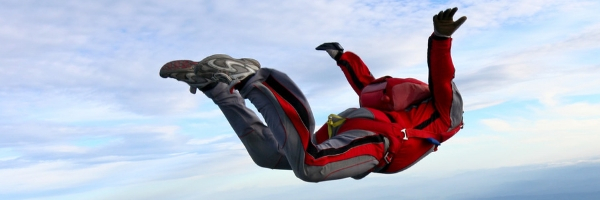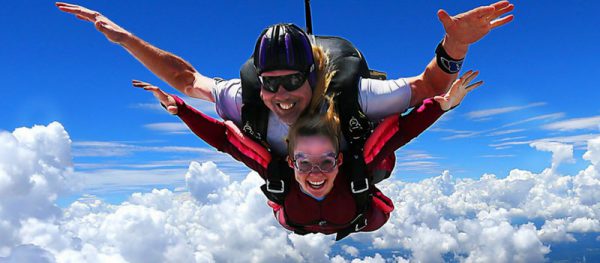What is it about the skydiving freefall that makes it so enticing to humans? We are basically monkeys, more at home on the ground – so why is something that should be at odds with what we are so high on people’s bucket lists? Something speaks to us about skydiving – it is cool and scary and a challenge that you can forever look on as a highlight of your life. Flying about in a plane is cool, and descending under a parachute is fun – but skydiving is really about the freefall. Let’s investigate the freefall in skydiving a bit more.

How Fast Do You Go in the Skydiving Freefall?
The most common answer you will hear is around 120mph. This is pretty much true, but is a simplified version of things representing the fall rate of skydivers using the traditional belly position that you most likely imagine when you think of what skydiving looks like.
120mph is a useful number to begin with, because the flat or ‘belly flying’ position is what you learn to do first – whether you are going for a tandem skydive or aiming to get a license of your own. Other disciplines in skydiving have different freefall speeds. For example, wingsuits (flying squirrel suits) have a lower freefall speed but allow their pilots to cover miles horizontally – while speed skydivers who point themselves vertically to go as fast as possible can go much, much faster (the world record is a blistering 373.6mph).
What Does the Freefall Feel Like?
The important part is how the speed generated by freefall feels. Sure, you can go faster than 120mph in an airplane or a fast car, but there is something incredibly thrilling about the speed generated simply by jumping out of an aircraft and falling through the air using only gravity to generate speed. The sensation of the wind on your body and the sound of the rushing air past your ears means that the skydiving freefall feels like the fastest thing in the world.
How Exactly Do You Freefall in the Air?
You just jump and fall, right? Yes, kinda – but no, not exactly. Your body falling through the air creates an effect called the ‘relative wind’ which is a force that can be used to move around. The first thing you aim for in a skydiving freefall is to breathe while remaining stable and in control. In the flat position, this means arching your body into a shape that performs like a shuttlecock – hips down towards the ground with your limbs and head up. This position is comfortable and the aerodynamic shape will keep you in the belly down orientation for the whole freefall. Using the relative wind to move around can eventually be done with amazing precision, but in the beginning, simple goals in this new environment are the way. If you are doing a tandem skydive for your first freefall, where you and your instructor go harnessed together – he or she might show you how to perform a simple turn which they will be right there to help you within the sky. If you are learning to get a skydiving license of your own, the first jump is all about stability and awareness – before you progress to movement a couple more jumps down the line.

Skydiving is simple and complicated all at the same time. On one hand, it is a process that has been refined over many decades to get people up jumping in the most accessible way possible. On the other, it is a technical and challenging extreme adventure sport that takes a lifetime to master. The important thing to understand is that whether you are approaching your first jump to experience the thrill of skydiving or have an eye on getting stuck in and becoming a master, freefall is a completely unique sensation that you cannot find anywhere else. Freefall can, and likely will change your life, and we are here to help you get started in the best possible way.
Copyright © 2024, Skydive Monroe, All Rights Reserved.
DropZone Web Design & Marketing by Beyond Marketing, LLC



